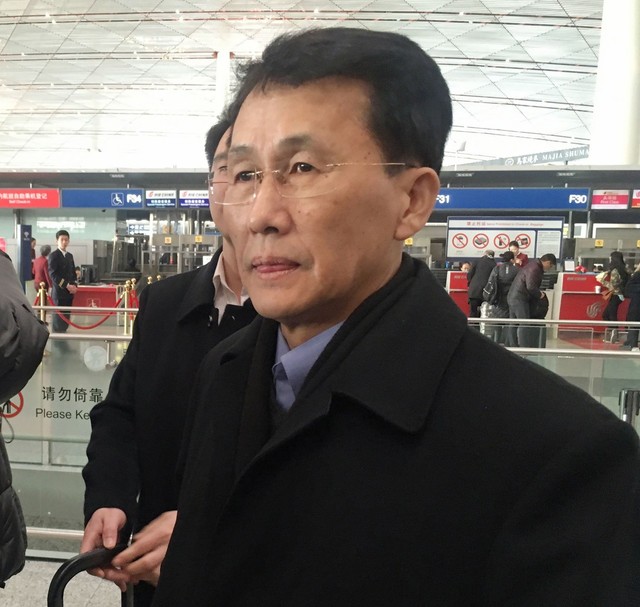 |
|
North American affairs bureau deputy director general Choe Kang-il waits at the Beijing Capital Airport to receive his boarding pass for a flight to Helsinki, Finland to take part in Track 1.5 talk on Mar. 19. (AP/Yonhap)
|
The two sides are meeting with South Korean representatives in Finland two months before a potential summit
North Korean leader Kim Jong-un and US President Donald Trump have been keeping relatively quiet about their upcoming summit, with little observable activity on either side with the event just two months away. The silence is being attributed to the lack of diplomatic channels between the two sides and the growing influence of their respective intelligence organizations. In terms of Pyongyang’s diplomatic channels, the focus has been on reconnaissance engagements on the periphery, with Foreign Minister Ri Yong-ho meeting on Mar. 15–17 with Swedish Foreign Minister Margot Wallström and North American affairs bureau deputy director general Choe Kang-il attending a trilateral Track 1.5 meeting in Helsinki on Mar. 20–21 with fellow attendees from South and North Korea and the US. At their talks, the North Korean and Swedish foreign ministers reportedly discussed issues concerning North Korea’s humanitarian situation, sanctions, and the release of three Korean-American detainees in the North. While the talks with Sweden – a third party in terms of North Korea-US issues – cannot be viewed as a deep discussion on Pyongyang’s part, they may have served as a way of indirectly exploring the mood in the US ahead of the summit. The Track 1.5 meeting in Finland was reportedly planned initially as an occasion to discuss relaxing tensions before decisions were made on the inter-Korean and North Korea-US summits. “This was organized before this rapid progress in the political situation, so there’s a bit of a feeling of coincidence,” said a source who asked to remain anonymous. After the recent shift in mood, North Korean officials are expected to trade relatively frank views on the two summits with experts from South Korea and the US. From Pyongyang’s standpoint, the Track 1.5 meeting could be an opportunity to gauge the US government and public’s hopes and concerns about the North Korea-US summit in more detail. A total 18 of people, or six representatives each, are attending from South and North Korea and the US, with Choe representing the North Korean side as deputy director of the Institute for American Studies, former ambassador to South Korea Kathleen Stephens representing the US, and Sejong Institute chairman Baek Jong-chun representing South Korea. The focus on “reconnaissance” from North Korea’s diplomatic line is seen as tied first and foremost with the mood amid preparations for the imminent inter-Korean summit. The outcome of that summit is seen as potential providing “content” from the North Korea-US summit to come. Also contributing to the development is the lack of a diplomatic counterpart on the US side. The State Department is currently facing a vacuum after the dismissal of Secretary of State Rex Tillerson and resignation of special representative for North Korea policy Joseph Yun. The “New York channel” used for official diplomatic efforts between the two sides has also not been active recently. Under the circumstances, Pyongyang and Washington will have resort to trading views and coordinating behind the scenes through intelligence channels as expedience dictates until nominee Mike Pompeo passes his Senate confirmation procedures to become the new Secretary of State in late April. Analysts are predicting discussions on the release of the three detained US nationals in North Korea will only materialize once Pompeo has been confirmed. While Sweden has performed consular duties in North Korea on the US’s behalf, practical discussions on detainee issues beyond their health status and visits have taken place through direct talks between North Korea and the US. By Yi Yong-in, Washington correspondent Please direct questions or comments to [english@hani.co.kr]






